| |
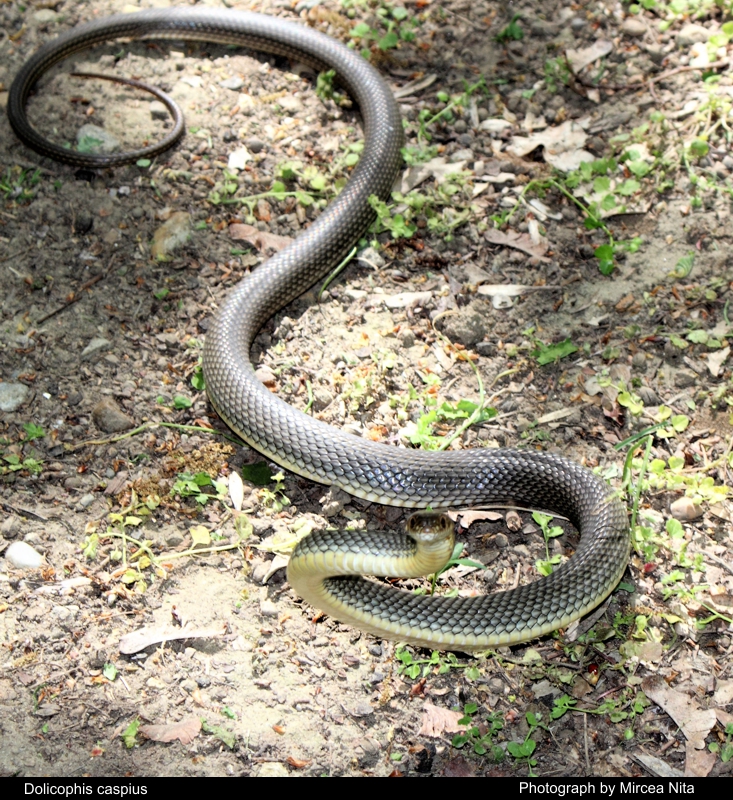
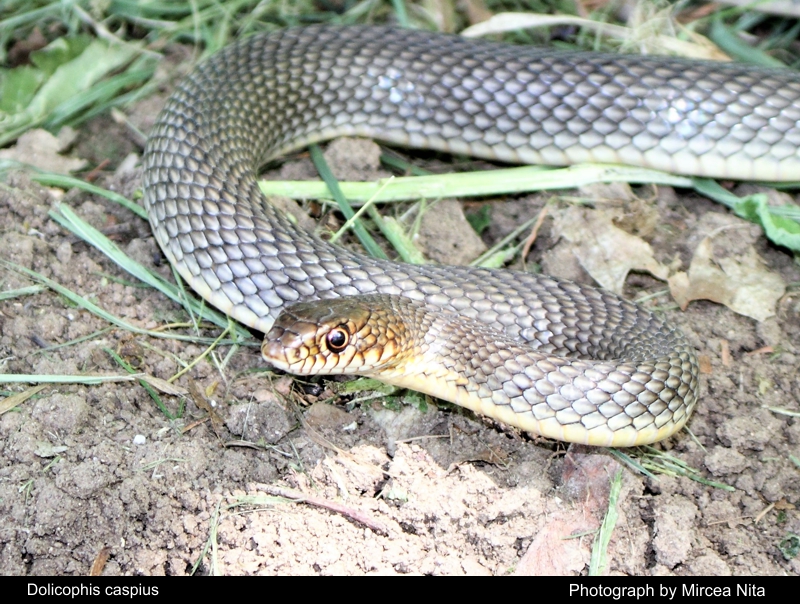
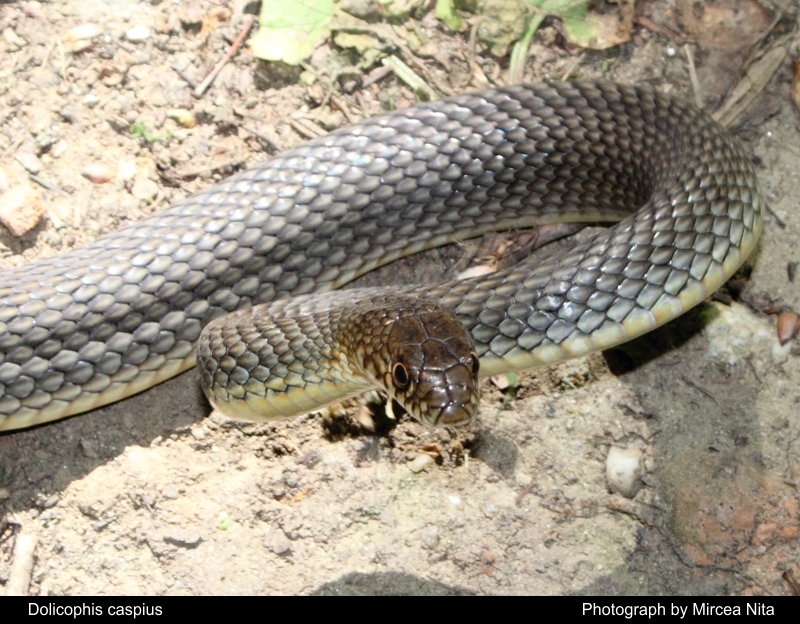
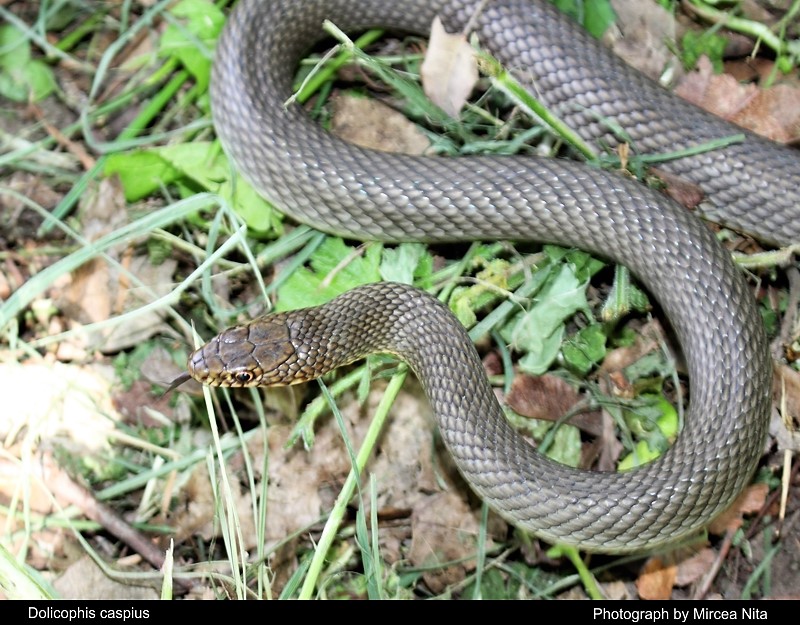
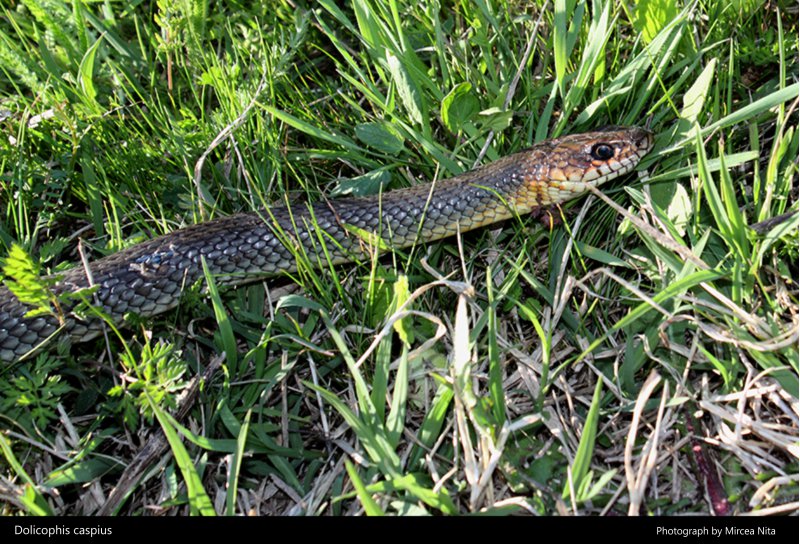 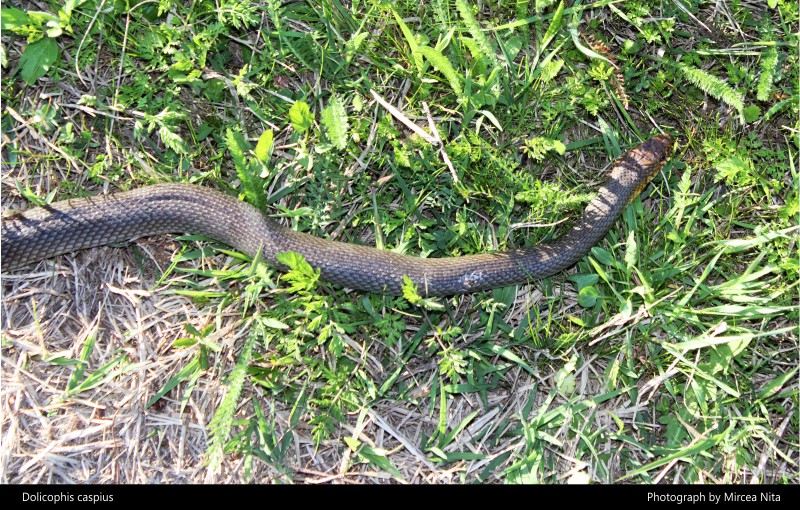
Dolichophis caspius
Caspian whipsnake - Dolichophis caspius - Gmelin, 1789
This non venomous snake is one of the most aggressive and fast species from Europe.
Description:
The Caspian whipsnake – member of Colubridae family - is one of the largest European species of snake and usually reaches lengths of 1.4 -1.65 meters, although it has been recorded reaching lengths as long as 2 meters. Typically, males have bigger heads and measure longer than females.Its rather small head is elongated, with round snout and distinct neck, the eyes being relatively large with round pupils. The tail is long and thin.
Dorsal scales are smooth and arranged in 19 transverse rows, rarely 17 or 21. The ventral plates are 160-211 in number and anal scale is divided.
The color of this species can be brown, yellowish brown, brown-gray, olive or reddish. Each dorsal scale presents one pale median stripe disposed longitudinally. The ventral side is yellowish and sides of the neck are sometimes yellowish-orange in color. The dorsal color of juveniles is brown or gray with dark spots which fade with age.
Biology:
The Caspian whipsnake diet consists in small mammals (mice, rats), lizards, small birds and other snakes.
Hunting during the day, it is the one of the fastest snake easily climbing on rocks, trees and shrubs.
This species is known for its aggressive nature, when provoked or threatened the snake striking repeatedly and forcefully biting.
Reproduction occurs in late May, the male grabs the female firmly by the neck and tail braiding around it.The Caspian whipsnake is oviparous, generally laying 5-12 eggs per clutch in June – July, which hatches in August. They reach sexual maturity approximately at 3 years old.
Habitat:
Dolichophis caspius inhabits a wide range of habitats: at the forest edge, near the bushes, among shrubby vegetation, in sunny embankments and meadows, rocky hillsides, rocky riverbanks and swampy areas.
Distribution:
The Caspian whipsnake can be found in the Balkan peninsula, parts of Eastern Europe and Asia Minor: Albania, Bulgaria, Greece, Croatia, Macedonia, Romania, , Bosnia and Herzegovina, Slovenia, Montenegro, southern Slovakia, Turkey, southern Hungary, southern Ukraine, Southern Russia, Kazakhstan, Jordan.
Scientific name: Dolichophis caspius
Common name: Caspian whipsnake
Taxonomy:
Species: Dolichophis caspius
Subspecies: Dolichophis caspius caspius (Gmelin, 1789)
Dolichophis caspius eiselti (Zinner, 1972)
IUCN Status: This taxon has not yet been assessed for the IUCN Red List.
It is listed on Annex II of the Bern Convention and is included in Annex IV of the EU Habitat Directive. The species is present in a number of protected areas throughout its range. It is protected by national legislation in most range states.
References:
Arnold, E.N. 2003. Reptiles and amphibians of Europe. Princeton University Press., Princeton and Oxford;
Council of Europe. 2003. Convention on the Conservation of European Wildlife and Natural Habitats. Group of experts on the conservation of Amphibians and Reptiles. Mälmo (Sweden), 26-27 September 2003. Report T-PVS (2003) 18.
Cog?lniceanu D., Rozylowicz L., Székely P., Samoil? C., St?nescu F., Tudor M., Székely D., Iosif R., (2013): Diversity and distribution of reptiles in Romania, ZooKeys 341: 49-76.
Covaciu-Marcov S.-D.; Ghira, I.; Cicort-Lucaciu A.-St., Sas I.; Strugariu, A. & Bogdan H. V. 2006. Contributions to knowledge regarding the geographical distribution of the herpetofauna of Dobrudja, Romania. North-Western Journal of Zoology 2 (2): 88-125
Fuhn, I. & S. Vancea, 1961: Fauna Republicii Române, 14. Reptilia (Testoase, Sopârle, Serpi). Bucuresti;
Gasc, J.-P., A. Cabela, J. Crnobrnja-Isailovic, D. Dolmen, K. Grossenbacher, P. Haffner, J. Lescure, H. Martens, J.P. Martinez-Rica, H. Maurin, M.E. Oliveira, T.S. Sofianidou, M. Veith & A. Zuiderwijk, 1997: Atlas of Amphibians and Reptiles in Europe. - Societas Europaea Herpetologica und Muséum National d'Historie Naturelle (IEGB/SPN), Paris;
IUCN 2011. IUCN Red List of Threatened Species. Version 2011.2. ;
Sahlean, T.C.; MES?TER, L.E. & CRA?CIUN, N. 2010. First distribution record for the large whip snake (Dolichophis caspius Gmelin, 1789) in the county of Teleorman (Islaz, Romania). Biharean Biologist 4 (2): 181-183;
Szczerbak, N.N. 2003. Guide to the Reptiles of the Eastern Palearctic. Krieger, Malabar, FL, 260 pp.;
Sos, T. 2008. Review of recent taxonomic and nomenclatural changes in European Amphibia and Reptilia related to Romanian herpetofauna. Herpetologica Romanica 2: 61-91;
Strugariu A., Gherghel I., (2007): New record on the occurance of Dolichophis caspius (Reptilia: Colubridae) in Romanian Moldavia. North-Western Journal of Zoology 3: 57-61.
| |

